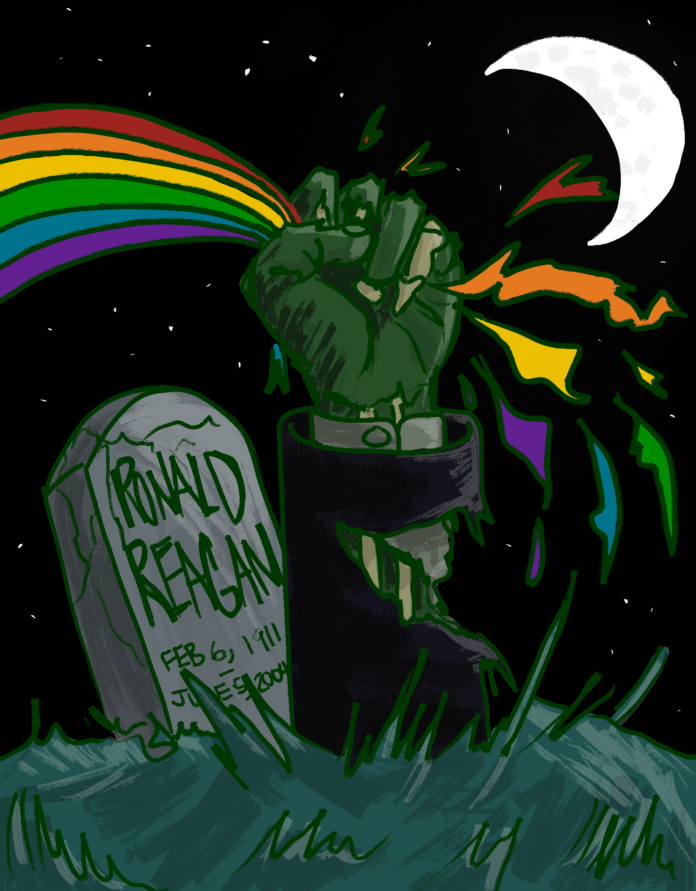Unpacking California’s conservative history and why it is extra relevant this year
By Tara Romero— tcrome@ucdavis.edu
“Trump is coming back to office, but because we’re in California, we have nothing to worry about” — this is a strange sentiment that has been floating around a lot in the past few months. Frankly, there’s a lot to unpack with that statement alone, but let’s start with questioning why this is the go-to remark for liberal Californians as we enter into another Trump presidency.
California has been a reliably blue state since 1988. On election night, our 54 electoral votes rolled in to give a huge push for the Democratic candidate. In recent years, our state has enacted plenty of progressive legislation, such as amending the state constitution to protect both reproductive rights in 2022 and same-sex marriage in 2024.
On paper, California appears to be a liberal oasis in the midst of a Trump presidency.
I cannot lie, I was naively brainwashed by this myth going into this last election. Surely, we all rolled our eyes at the attempt of backtracking on Proposition 47. Undoubtedly, my fellow Californians would vote to end the enslavement of people who are incarcerated, since it’s a human rights violation and there was literally no argument submitted against it.
When I woke up the morning after the election, I’m embarrassed to admit that I was blindsided by the results of Proposition 6 and 36. However, remembering California’s history, these results really should not have come as such a surprise.
While California has passed notable progressive reform in recent years, only a few decades ago was California also at the helm of regressive politics. In case we forgot, two of the most infamous presidents in American history were California politicians: Richard Nixon and Ronald Reagan.
Aside from the classic fumble of Watergate, Nixon was also known for his devotion to bringing “law and order” to America. This platform spoke to the racist frustration of the white lower class following the Civil Rights Movement. “Law and order” rhetoric is also the predecessor to the “Tough on Crime” movement in the following decades.
In his presidency, Ronald “don’t worry it will trickle down, I promise” Reagan notably did absolutely nothing in the face of the AIDS epidemic. His campaign was fueled by creating and then fighting the imaginary “War on Drugs.” He criminalized drug usage by signing the “Anti-Drug Abuse Act of 1986,” which spurred increased drug laws on the state level throughout the country — including California.
After Reagan’s presidency, California went on to be a leader in passing new “Tough on Crime” laws, which disproportionately targeted Black and Latino Californians. In 1994, California was the second state to pass the “Three Strikes Law,” which exponentially increased punishments for people who had been convicted of a previous felony. Currently, there are still roughly 4,800 laws that place restrictions on previously incarcerated people’s rights including employment, housing and education.
It wasn’t until the 2010s that California finally began to try to reform the mess that is our criminal legal system. The state passed more progressive measures like Proposition 47, which reclassified petty theft and drug possession from felony to misdemeanor — undone by passing Prop. 36 on last year’s ballot.
The failure of Prop. 6 (you remember, the one that would have prohibited the enslavement of people who are incarcerated), and the passing of Prop. 36 (reclassifying petty theft and drug possession back into a felony) in the 2024 election jointly marked California’s return to its “Tough on Crime” roots.
Understanding our state’s history, particularly in the criminal legal system, helps us see how California was never the left-wing wonderland that both sides of the political spectrum claim it to be. We have continuously failed, exploited and neglected our most marginalized communities. Our progressive reforms are only as strong as their legacy, and if some of our most crucial reforms get backtracked only 10 years later, then we have a lot to worry about.
Understandably, California will likely not be as deeply affected as many other, more vulnerable, states during Trump’s presidency. Yet, we cannot continue to hide ourselves under the myth that California is a liberal safe haven because it’s not. The myth of liberalism can only protect us for so long and has already failed to protect those of us affected by mass incarceration. The reality is: California was never all that far left. So, consider this myth — busted.
Written by: Tara Romero— tcrome@ucdavis.edu
Disclaimer: The views and opinions expressed by individual columnists belong to the columnists alone and do not necessarily indicate the views and opinions held by The California Aggie.





